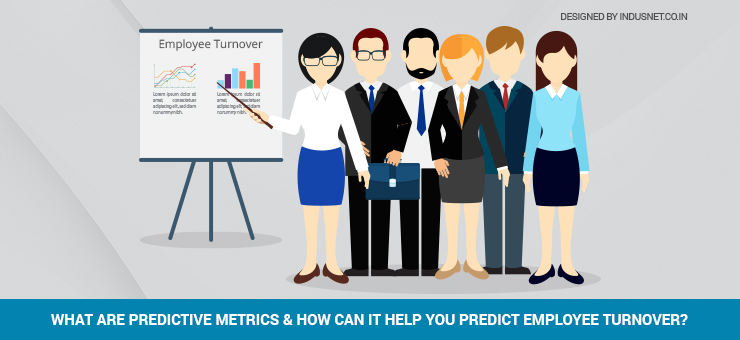
Businesses are prone to risks of market volatility. Ability to deal with such risks is heightened by human capital risks. It is always difficult for HR managers to predict which employees are likely to quit. Business owners have often paid least attention to HR department owing to its inability to contribute towards strategic business decisions.
Employee dissatisfaction or any other latent reason may trigger a sudden exodus of employees from a company. This can cost heavily to the company leading to loss of business productivity, bad reputation in the market, customer dissatisfaction and deterioration of work quality.
Instinctive prediction can be misleading because it is not supported by facts. Predictive metrics follows a purely data-driven approach and is gaining importance through its impact on talent management function.
What is predictive metrics?
Predictive metrics is a value-added process for HR managers to enhance their decision-making abilities by defining factors associated with employee turnover. Managers can use parameters like employee history, job functions held, the time between promotions, the time between change of job, personal data, current profile, time spent in current profile, employee performance, and many other business factors to take informed decisions and help their company to grow. The data can also be put to use to find out which departments or teams face a higher risk of turnover.
[php snippet=1]
Predictive metrics allow businesses to identify and understand risks associated with employee retention. Such metrics may include the number of top performers at high risk of resigning in the next one year and costs associated with filling the vacancy.
A number of HR analytics applications have surfaced in the market that assists in the processing of real-time data. Analysts use various three-dimensional predictive metrics to understand employee turnover patterns. Firstly, it is important to study turnover patterns in the past few years. Secondly, how have those patterns evolved over the past years. Thirdly, what new metrics can be taken into account that affects employee turnover.
What does predictive metrics do?
How does predictive metrics help in anticipating attrition?
Assessment of employee productivity plays an important role in predictive metrics. Factors that positively impact productivity can be highly useful to HR managers. A graphical representation of employee productivity curve will give an insight into problems and corrective measures can be taken.
Employee behavioral issues are often neglected in the organization. Negative behavior among employees has strong implication for attrition. Metrics like negligence, punctuality, absenteeism, sick leave, low morale, lack of commitment etc can be used to suggest effective solutions to deal with behavioral problems.
Progression of new hires is critical to understand the quality of recruitment. Career trajectory can help managers to understand how fast new hires are likely to grow and contribute towards organizational success. It can further help them to predict the duration of their stay in the organization. Personal and professional goals should be in line to ensure that the employee does not quit. A similar progression can be drawn for existing employees in the company.
A successful manager ensures that every team member is happy. Apart from that, he is responsible for productivity, innovation, hiring and control employee turnover. Identify the metrics that defines the success of a manager. Such metrics can help you to identify and improve weak managers. It can also help you to spot employees capable to become a successful manager.
A similar metrics can be drawn to identify new hires and current employees with good leadership capabilities.
HR managers are poorly prepared to predict large position openings. Establishing metrics that help them to predict what position will have maximum openings in future can lead to better planning for training, internal promotions or need for external hiring. Failure to do so negatively impacts business causing a sudden peak in turnover.
Predictive metrics enable HR managers to hire talent at the right time. Hiring when all your competitors are aggressively hiring is not a good hiring tactic. Predictive metrics helps to identify the right time for your organization to hunt for talent to get most qualified and talented candidates. It also helps you to spot surplus talent in certain areas in the organization so that you can plan to fill up top positions well in advance.
Hiring is not always a necessity. Many a time, organizations respond to market dynamics to layoff. Predictive metric helps you to forecast the need for shrinking. Once you know, shrinking is imperative, you can concentrate to spot and hold the best talent in the organization.
Predictive metrics helps you to conduct an internal movement of employees. There are times when employee shuffling is important to bring new energy and improve the productivity of the organization. Employees with a suitable set of skills can be deployed in better positions to exploit their talent and avoid work dissatisfaction.
Predictive metrics allows HR managers to project the need for temporary or contract workers. An organization may require extra manpower for a short duration or during the course of a particular project. Rather than hiring full-time employees which are an additional burden on human capital, part-time workers can be hired. Hiring full-time employees and then suddenly laying them off projects a negative image about the organization. Employees are likely to be disloyal and hence become a reason for high attrition rate.
If an organization is growing old, with a majority of mid-aged and older employees, it likely to face many retirements in the coming years thereby causing high employee turnover. Under such scenario, predictive metrics is used to forecast upcoming retirements and accordingly plan for the hiring of fresh talent and young workforce.
Predictive metrics helps HR managers to analyze real-time HR data and provide recommendations based on that. It is necessary to use predictive analysis to improve employee retention, employee performance and ultimately generate more business revenue. Overall, an organization is empowered to take good business decisions with predictive metrics.